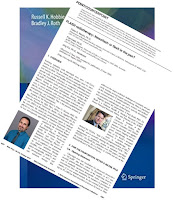 |
| “FLASH Radiotherapy: Newsflash or Flash in the Pan?” (Med. Phys. 46:4287–4290, 2019). |
The format for any Point/Counterpoint article is a debate between two leading experts. Each provides an opening statement and then they finish with rebuttals. In this case, Pater Maxim argues for the proposition (Newsflash!), and Paul Keall argues against it (Flash in the Pan). The moderator, Jing Cai, provides an introductory overview:
Ionizing radiation with ultra-high dose rates (>40 Gy/s), known as FLASH, has drawn great attention since its introduction in 2014. It has been shown to markedly reduce radiation toxicity to normal healthy tissues while inhibiting tumor growth with similar efficiency as compared to conventional dose rate irradiation in pre-clinical models. Some believe that FLASH irradiation holds great promise and is perhaps the biggest finding in recent radiotherapy history. However, others remain skeptical about the replication of FLASH efficacy in cancer patients with concerns about technical complexity, lack of understanding of its molecular radiobiological underpinnings, and reliability. This is the premise debated in this month’s Point/Counterpoint.
I find it interesting that the mechanism for FLASH remains unknown. In his opening statement, Maxim says “we have barely scratched the surface of potential mechanistic pathways.” After citing several animals studies, he concludes that “these data provide strong evidence that the observed FLASH effect across multiple species and organ systems is real, which makes this dramatic finding the biggest 'Newsflash' in recent radiotherapy history.”
In his opening statement, Keall says that “FLASH therapy is an interesting concept… However, before jumping on the FLASH bandwagon, we should ask some questions.” His questions include “Does FLASH delivery technology exist for humans?” (No), “Will FLASH be cost effective? (No), “Will treatment times be reduced with FLASH therapy?” (Possibly), and “Are the controls questionable in FLASH experiments?” (Sometimes). He concludes by asking “Am I on the FLASH bandwagon? No. I remain an interested spectator.”
Maxim, in his rebuttal, claims that while FLASH is not currently available for treatment of humans, he sees a pathway for clinical translation in the foreseeable future, based on something called Pluridirectional High-Energy Agile Scanning Electronic Radiotherapy (PHASER). Moreover, he anticipates that PHASER will have an overall cost similar to conventional therapy. He notes that one motivation for adopting the FLASH technique is to reduce uncertainty caused by organ motion. Maxim concludes that “FLASH promised to be a paradigm shift in curative radiation therapy with preclinical evidence of fundamentally improved therapeutic index. If this remarkable finding is translatable to humans, the switch to the PHASER technology will become mandatory.”
Keall, in his rebuttle, points out weaknesses in the preclinical FLASH studies. In particular, studies so far have looked at only early biological effects, but late effects (perhaps years after treatment) are unknown. He also states that “FLASH works against one of the four R’s of radiobiology, reoxygenation.” Traditionally, a tumor has a hypoxic core meaning its has a low level of oxygen at its center, and this makes it resistant to radiation damage. When radiation is delivered in several fractions, there is enough time for a tumor to reoxygenate between fractions. This, in fact, is the primary motivation for using fractions. FLASH happens so fast there is no time for reoxygenation. This is why the mechanism of FLASH remains unclear: it goes against conventional ideas. Keall concludes “The scientists, authors, reviewers and editors involved with FLASH therapy need to carefully approach the subject and acknowledge the limitations of their studies. Overcoming these limitations will drive innovation. I will watch this space with interest.”
So what do I make of all this? From the point of view of a textbook writer, we really need to figure out the mechanism underlying FLASH. Otherwise, textbooks hardly know how to describe the technique, and optimizing it for the clinic will be difficult. Nevertheless, the new edition of Intermediate Physics for Medicine and Biology will have something to say about FLASH.
FLASH seems promising enough that we should certainly explore it further. But as I get older, I seem to be getting more conservative, so I tend to side with Keall. I would love to see the method work on patients, but I remain a skeptic until I see more evidence. I guess it depends on if you are a cup-half-full or a cup-half-empty kind of guy. I do know one thing: Point/Counterpoint articles help me understand the pros and cons of such difficult and technical issues.



No comments:
Post a Comment